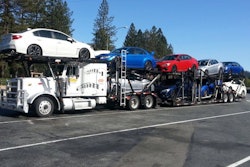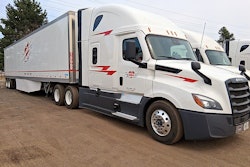Average monthly depreciation for daycabs in the 2024 used market is significantly higher than both historical averages and the sleeper segment at 4.1%, according to J.D. Power’s August 2024 Commercial Truck Guidelines report.
J.D. Power noted that limited retail sales make it difficult to pinpoint month-over-month changes in the daycab segment, but auction data suggest this segment is undergoing a correction. Late-model daycabs saw retail prices drop 11.8% in July compared to June and brought in 32.6% less money compared to July 2023.
The company reported that heavier-spec tractors and those with low-mileage units are still commanding strong prices, but typical highway-spec, 13L units with average mileage have experienced steep depreciation in the third quarter.
Volume in the auction market declined in July 2024 with prices remaining at rock-bottom levels, J.D. Power’s report said. Retail volume returned to its usual pace, and depreciation followed a normal pattern.
On the auction side, volumes were down significantly from June, which J.D. Power said is typical for the month. In July, the company said that selling prices for 4- to 6-year-old sleepers were 13.7% higher than June. July’s price increase brought nominal figures back in line with the strong pre-pandemic levels of 2018, though they are approximately 21% lower than adjusted for inflation.
On the retail side, volume recovered June’s dip and pricing was incrementally lower. J.D. Power said that in June, the average sleeper was four months newer, had 8,992 (2.0%) fewer miles and brought $5,185 (9.2%) more. Compared to July last year, the average sleeper was 10 months newer, had 24,779 (5.3%) fewer miles and brought $5,008 (7.5%) less.
Three- to 5-year-old sleeper tractors sold for 1% less money in July than in June and 8.3% less than July 2023. Late-model sleepers are now bringing slightly less than they did during the strong pre-pandemic period of early 2019 in nominal terms. Compared to the last weak pre-pandemic period, late-model sleeper values are 22% higher in nominal dollars or essentially equal money in real dollars. Depreciation in 2024 is averaging 2.3% per month, which is in line with historical trends.
Chris Visser, director of specialty vehicles at J.D. Power, noted that the supply of daycabs available to the marketplace increased earlier this year due to fleet bankruptcies and end users exiting the industry.
“The market is now saturated,” Visser said.
Visser noted that daycabs should depreciate similarly to slightly greater than sleepers into next year, with increased daycab supply due to inventory adjustments and bankruptcy liquidations just like the sleeper segment.
Jack Mitchell, senior vice president of remarketing at Penske Truck Leasing, said it is a supply and demand issue.
"The used-truck inventory has doubled in the past year," he said. "With freight being down, we are seeing less demand in the marketplace.”
Jason Miller, supply chain professor at the Eli Broad College of Business at Michigan State University, commented, “It sounds like prices are likely bouncing around on a floor more than anything else, which would make sense because we are seeing (across all of trucking) a stabilization of freight volumes (measured by the for-hire trucking ton-mile index) to where we are moving along the bottom of a trough.”
Miller said that revenues earned by for-hire carriers of all types have likewise bottomed out and may even be slightly rising in total, albeit down from record levels observed from Q4 2021 to Q3 2022.
On another hand, Visser noted that the same fundamental imbalance between supply and demand that caused sleeper values to decline starting in 2022 is now present in the daycab market, although not to the same magnitude.
Mitchell said inventory is up on the sleeper side, and freight is down.
“There are a record number of units that are going to auction," he said. "There also are other industry factors like the Yellow bankruptcy. There is more supply than demand.”
[RELATED: How a Yellow bankruptcy would influence freight, used truck markets]
Looking ahead, Mitchell said several factors that could impact the value of daycab and sleeper include the cost of new equipment, interest rates, age of equipment and supply and demand.
Visser said sleeper values have stabilized, and the market has absorbed the worst of the oversupply in that segment, at least for the time being.
“Excess daycabs will eventually cycle through the market, which will stabilize that segment, albeit at a lower level than last year,” he added.













